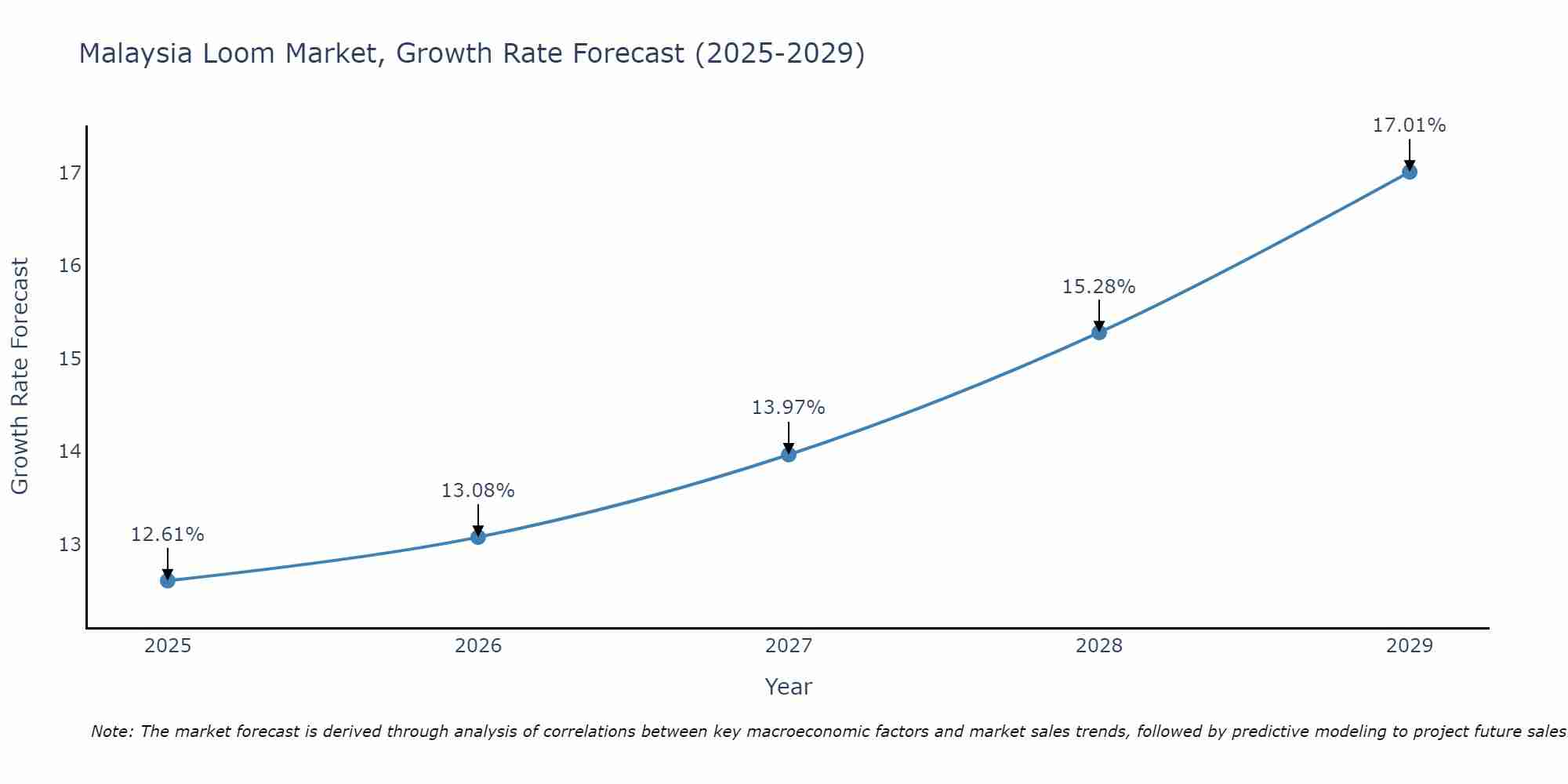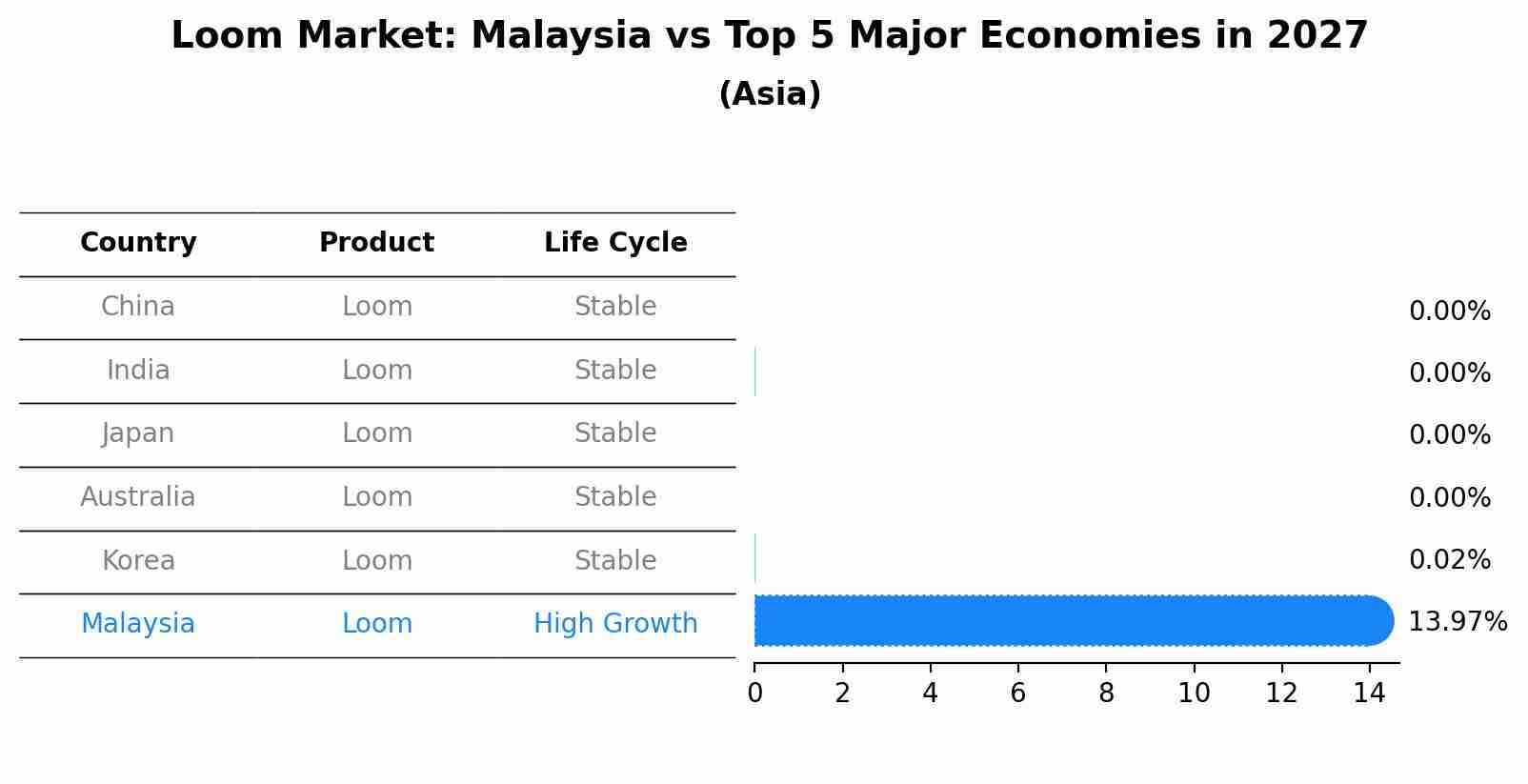Malaysia Loom Market (2025-2031) Outlook | Forecast, Growth, Trends, Industry, Size, Share, Revenue, Value, Companies & Analysis
| Product Code: ETC428842 | Publication Date: Oct 2022 | Updated Date: Aug 2025 | Product Type: Market Research Report | |
| Publisher: 6Wresearch | No. of Pages: 75 | No. of Figures: 35 | No. of Tables: 20 | |
Malaysia Loom Market Size Growth Rate
The Malaysia Loom Market is poised for steady growth rate improvements from 2025 to 2029. The growth rate starts at 12.61% in 2025 and reaches 17.01% by 2029.

Loom Market: Malaysia vs Top 5 Major Economies in 2027 (Asia)
The Loom market in Malaysia is projected to grow at a high growth rate of 13.97% by 2027, within the Asia region led by China, along with other countries like India, Japan, Australia and South Korea, collectively shaping a dynamic and evolving market environment driven by innovation and increasing adoption of emerging technologies.

Malaysia Loom Market Synopsis
In Malaysia, the loom market has been experiencing steady growth, driven by the textile and apparel industry. The demand for traditional woven products as well as modern fabrics has contributed to the market`s stability. Additionally, the adoption of advanced loom technologies has enhanced efficiency and product quality.
Drivers of the Market
The loom market in Malaysia is poised for steady growth in the coming years. Factors driving this growth include a burgeoning textile industry, rising demand for traditional and contemporary fabrics, and increased export opportunities. Additionally, technological advancements in loom machinery are enhancing production efficiency and quality, further boosting market prospects. The government`s initiatives to promote the textile sector and attract foreign investments are also expected to play a pivotal role in the market`s expansion.
Challenges of the Market
The Malaysia loom market may have experienced steady growth due to the textile industry`s presence in the country. Factors such as increasing demand for textiles, technological advancements in loom machinery, and government initiatives to promote the textile sector could have contributed to this growth. However, challenges like competition from other textile-producing countries and fluctuations in raw material prices may have posed hurdles.
COVID-19 Impact on the Market
The Malaysia loom market has shown resilience in recent years, with steady demand driven by the textile and apparel industry. Despite disruptions caused by the COVID-19 pandemic, the market is expected to recover as the economy stabilizes. Increasing adoption of advanced loom technologies and the country`s focus on promoting textile exports are likely to contribute to the market`s growth.
Key Players in the Market
The Malaysia loom market is a vibrant and dynamic sector with significant growth potential. In recent years, the industry has witnessed steady expansion, driven by several genuine key players who have made substantial contributions to its development. One of the foremost genuine key players in the Malaysia loom market is "Teratak Weaving," a renowned manufacturer known for its high-quality handwoven textiles. Teratak Weaving has carved a niche for itself in the market by preserving traditional weaving techniques while incorporating modern designs. Their commitment to preserving cultural heritage while adapting to contemporary trends has helped them maintain a strong presence in the market. Another prominent player is "Lim`s Handloom," which has been operating for decades and has a strong reputation for producing exquisite handwoven fabrics. They are known for their intricate patterns and a wide range of textile products, making them a sought-after choice for both domestic and international customers. "Seri Setia Kreatif," a textile manufacturer specializing in innovative and sustainable loom products, has also emerged as a key player in the Malaysia market. They are at the forefront of incorporating eco-friendly practices into their production processes, appealing to environmentally conscious consumers. "Woven Dreams Malaysia" is a boutique manufacturer that has made a name for itself by producing bespoke handwoven textiles. Their dedication to customization and attention to detail has earned them a loyal customer base, particularly in the high-end fashion and interior design sectors.
Key Highlights of the Report:
- Malaysia Loom Market Outlook
- Market Size of Malaysia Loom Market, 2024
- Forecast of Malaysia Loom Market, 2031
- Historical Data and Forecast of Malaysia Loom Revenues & Volume for the Period 2021-2031
- Malaysia Loom Market Trend Evolution
- Malaysia Loom Market Drivers and Challenges
- Malaysia Loom Price Trends
- Malaysia Loom Porter's Five Forces
- Malaysia Loom Industry Life Cycle
- Historical Data and Forecast of Malaysia Loom Market Revenues & Volume By Type for the Period 2021-2031
- Historical Data and Forecast of Malaysia Loom Market Revenues & Volume By Hand Loom for the Period 2021-2031
- Historical Data and Forecast of Malaysia Loom Market Revenues & Volume By Shuttle Loom for the Period 2021-2031
- Historical Data and Forecast of Malaysia Loom Market Revenues & Volume By Modern Loom for the Period 2021-2031
- Historical Data and Forecast of Malaysia Loom Market Revenues & Volume By Projectile Loom for the Period 2021-2031
- Historical Data and Forecast of Malaysia Loom Market Revenues & Volume By Air Jet Loom for the Period 2021-2031
- Historical Data and Forecast of Malaysia Loom Market Revenues & Volume By Multiphase Loom for the Period 2021-2031
- Historical Data and Forecast of Malaysia Loom Market Revenues & Volume By Applications for the Period 2021-2031
- Historical Data and Forecast of Malaysia Loom Market Revenues & Volume By Home Use for the Period 2021-2031
- Historical Data and Forecast of Malaysia Loom Market Revenues & Volume By Commercial Use for the Period 2021-2031
- Malaysia Loom Import Export Trade Statistics
- Market Opportunity Assessment By Type
- Market Opportunity Assessment By Applications
- Malaysia Loom Top Companies Market Share
- Malaysia Loom Competitive Benchmarking By Technical and Operational Parameters
- Malaysia Loom Company Profiles
- Malaysia Loom Key Strategic Recommendations
Frequently Asked Questions About the Market Study (FAQs):
1 Executive Summary |
2 Introduction |
2.1 Key Highlights of the Report |
2.2 Report Description |
2.3 Market Scope & Segmentation |
2.4 Research Methodology |
2.5 Assumptions |
3 Malaysia Loom Market Overview |
3.1 Malaysia Country Macro Economic Indicators |
3.2 Malaysia Loom Market Revenues & Volume, 2021 & 2031F |
3.3 Malaysia Loom Market - Industry Life Cycle |
3.4 Malaysia Loom Market - Porter's Five Forces |
3.5 Malaysia Loom Market Revenues & Volume Share, By Type, 2021 & 2031F |
3.6 Malaysia Loom Market Revenues & Volume Share, By Applications, 2021 & 2031F |
4 Malaysia Loom Market Dynamics |
4.1 Impact Analysis |
4.2 Market Drivers |
4.2.1 Growing demand for traditional and cultural textiles in Malaysia |
4.2.2 Increasing adoption of sustainable and eco-friendly weaving practices |
4.2.3 Government initiatives to promote the textile and handicraft industry in Malaysia |
4.3 Market Restraints |
4.3.1 High competition from imported looms and mass-produced textiles |
4.3.2 Fluctuating raw material prices affecting production costs |
4.3.3 Limited access to advanced technology and machinery for weaving |
5 Malaysia Loom Market Trends |
6 Malaysia Loom Market, By Types |
6.1 Malaysia Loom Market, By Type |
6.1.1 Overview and Analysis |
6.1.2 Malaysia Loom Market Revenues & Volume, By Type, 2021-2031F |
6.1.3 Malaysia Loom Market Revenues & Volume, By Hand Loom, 2021-2031F |
6.1.4 Malaysia Loom Market Revenues & Volume, By Shuttle Loom, 2021-2031F |
6.1.5 Malaysia Loom Market Revenues & Volume, By Modern Loom, 2021-2031F |
6.1.6 Malaysia Loom Market Revenues & Volume, By Projectile Loom, 2021-2031F |
6.1.7 Malaysia Loom Market Revenues & Volume, By Air Jet Loom, 2021-2031F |
6.1.8 Malaysia Loom Market Revenues & Volume, By Multiphase Loom, 2021-2031F |
6.2 Malaysia Loom Market, By Applications |
6.2.1 Overview and Analysis |
6.2.2 Malaysia Loom Market Revenues & Volume, By Home Use, 2021-2031F |
6.2.3 Malaysia Loom Market Revenues & Volume, By Commercial Use , 2021-2031F |
7 Malaysia Loom Market Import-Export Trade Statistics |
7.1 Malaysia Loom Market Export to Major Countries |
7.2 Malaysia Loom Market Imports from Major Countries |
8 Malaysia Loom Market Key Performance Indicators |
8.1 Number of skilled weavers trained annually |
8.2 Percentage increase in revenue from sales of locally produced textiles |
8.3 Adoption rate of sustainable weaving practices |
8.4 Average production efficiency rate of looms in Malaysia |
8.5 Number of government-supported programs for the textile industry |
9 Malaysia Loom Market - Opportunity Assessment |
9.1 Malaysia Loom Market Opportunity Assessment, By Type, 2021 & 2031F |
9.2 Malaysia Loom Market Opportunity Assessment, By Applications, 2021 & 2031F |
10 Malaysia Loom Market - Competitive Landscape |
10.1 Malaysia Loom Market Revenue Share, By Companies, 2024 |
10.2 Malaysia Loom Market Competitive Benchmarking, By Operating and Technical Parameters |
11 Company Profiles |
12 Recommendations |
13 Disclaimer |
- Single User License$ 1,995
- Department License$ 2,400
- Site License$ 3,120
- Global License$ 3,795
Search
Related Reports
- ASEAN Bearings Market (2025-2031) | Strategy, Consumer Insights, Analysis, Investment Trends, Opportunities, Growth, Size, Share, Industry, Revenue, Segments, Value, Segmentation, Supply, Forecast, Restraints, Outlook, Competition, Drivers, Trends, Demand, Pricing Analysis, Competitive, Strategic Insights, Companies, Challenges
- Europe Flooring Market (2025-2031) | Outlook, Share, Industry, Trends, Forecast, Companies, Revenue, Size, Analysis, Growth & Value
- Saudi Arabia Manlift Market (2025-2031) | Outlook, Size, Growth, Trends, Companies, Industry, Revenue, Value, Share, Forecast & Analysis
- Uganda Excavator, Crane, and Wheel Loaders Market (2025-2031) | Strategy, Consumer Insights, Analysis, Investment Trends, Opportunities, Growth, Size, Share, Industry, Revenue, Segments, Value, Segmentation, Supply, Forecast, Restraints, Outlook, Competition, Drivers, Trends, Demand, Pricing Analysis, Competitive, Strategic Insights, Companies, Challenges
- Rwanda Excavator, Crane, and Wheel Loaders Market (2025-2031) | Strategy, Consumer Insights, Analysis, Investment Trends, Opportunities, Growth, Size, Share, Industry, Revenue, Segments, Value, Segmentation, Supply, Forecast, Restraints, Outlook, Competition, Drivers, Trends, Demand, Pricing Analysis, Competitive, Strategic Insights, Companies, Challenges
- Kenya Excavator, Crane, and Wheel Loaders Market (2025-2031) | Strategy, Consumer Insights, Analysis, Investment Trends, Opportunities, Growth, Size, Share, Industry, Revenue, Segments, Value, Segmentation, Supply, Forecast, Restraints, Outlook, Competition, Drivers, Trends, Demand, Pricing Analysis, Competitive, Strategic Insights, Companies, Challenges
- Angola Excavator, Crane, and Wheel Loaders Market (2025-2031) | Strategy, Consumer Insights, Analysis, Investment Trends, Opportunities, Growth, Size, Share, Industry, Revenue, Segments, Value, Segmentation, Supply, Forecast, Restraints, Outlook, Competition, Drivers, Trends, Demand, Pricing Analysis, Competitive, Strategic Insights, Companies, Challenges
- Israel Intelligent Transport System Market (2025-2031) | Strategy, Consumer Insights, Analysis, Investment Trends, Opportunities, Growth, Size, Share, Industry, Revenue, Segments, Value, Segmentation, Supply, Forecast, Restraints, Outlook, Competition, Drivers, Trends, Demand, Pricing Analysis, Competitive, Strategic Insights, Companies, Challenges
- Uganda Precast and Aggregate Market (2025-2031) | Strategy, Consumer Insights, Analysis, Investment Trends, Opportunities, Growth, Size, Share, Industry, Revenue, Segments, Value, Segmentation, Supply, Forecast, Restraints, Outlook, Competition, Drivers, Trends, Demand, Pricing Analysis, Competitive, Strategic Insights, Companies, Challenges
- Australia IT Asset Disposal Market (2025-2031) | Strategy, Consumer Insights, Analysis, Investment Trends, Opportunities, Growth, Size, Share, Industry, Revenue, Segments, Value, Segmentation, Supply, Forecast, Restraints, Outlook, Competition, Drivers, Trends, Demand, Pricing Analysis, Competitive, Strategic Insights, Companies, Challenges
Industry Events and Analyst Meet
Our Clients
Whitepaper
- Middle East & Africa Commercial Security Market Click here to view more.
- Middle East & Africa Fire Safety Systems & Equipment Market Click here to view more.
- GCC Drone Market Click here to view more.
- Middle East Lighting Fixture Market Click here to view more.
- GCC Physical & Perimeter Security Market Click here to view more.
6WResearch In News
- Doha a strategic location for EV manufacturing hub: IPA Qatar
- Demand for luxury TVs surging in the GCC, says Samsung
- Empowering Growth: The Thriving Journey of Bangladesh’s Cable Industry
- Demand for luxury TVs surging in the GCC, says Samsung
- Video call with a traditional healer? Once unthinkable, it’s now common in South Africa
- Intelligent Buildings To Smooth GCC’s Path To Net Zero













